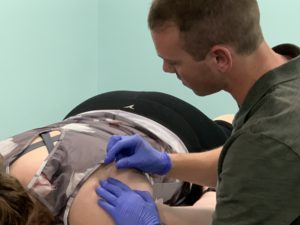Dry needling is a treatment involving a thin needle, used to target a painful trigger point. A physical therapist feels for the trigger point and then inserts the needle. The needle helps to release the tightness, stimulate blood flow, and promote relaxation to the aggravated muscle. Dry needling is one possible treatment option to be used in conjunction with massage, exercise, heat/ice to help manage pain. Results can vary from person to person and can range from very short term (hours-days) to more permanent effects. A physical therapist in the state of Maryland receives special education after physical therapy school to receive a certification in dry needling. At Harbor Physical Therapy, Dr. David Reymann is a certified myofascial trigger point therapist. If you are interested in trying dry needling or learning more about it, give Harbor Physical Therapy a call at 443-524-0442. 
pain
Cervicogenic Headache Vs. Migraine Headache
Cervicogenic Headaches stem from structures inside the neck and can radiate to the neck, back, front of the shoulders, scapula, down the arm, and chest. Migraine headaches are a disorder of the central nervous system involving nerves and blood vessels. Migraine headaches are throbbing recurring headaches that are typically found on one side of your head.
Cervicogenic Headache
Symptoms:
These patients may report an increase in headache frequency and intensity, decreased ability to turn their head, increased pain with prolonged sitting postures, neck pain, muscle tightness and tenderness, arm and shoulder pain, weakness, dizziness, nausea and light headedness.
Causes:
Joint stiffness in the neck, muscle and tissue tightness, multiple trigger points, or nerve irritation may lead to cervicogenic headaches.
Treatment:
Physical Therapy provides soft tissue massage, trigger point release, dry needling, stretching, modalities, joint mobilizations, strengthening postural muscles, and addressing proper body mechanics to decrease headache intensity and frequency.
Migraine Headache
Symptoms:
Migraines can have an aura or no aura. An aura is a visual disturbance that informs you of a migraine onset. Common auras are losing vision, seeing zig zags, light sensitivity, or flashing light colors. A migraine headache causes increased pain and throbbing on one side of your head.
Causes:
There are many causes to migraine headaches. Some examples are loud noises, bright lights, food, weather changes, lack of sleep, menstruation, and smoking.
Treatment:
Determining the trigger for your migraine headache and working towards preventing it from happening. Physical Therapy provides modalities, massage, stretching, and traction to help diminish symptoms and decrease frequency and severity. Physical Therapy will teach you how to perform self massage and self traction to help diminish your symptoms. In severe cases where migraines are daily or several times a week, medication is prescribed.
Cortisone Injection
A Cortisone shot is an injection that is given to decrease pain and inflammation. Most doctors limit an individual to 2 or 3 injections per area over a 12 month period because repeated injections may lead to tissue damage. Some patients might get a cortisone injection prior to beginning physical therapy. Some patients may not get an injection unless pain is preventing progress with physical therapy.
Can a Flu Shot Cause Long Lasting Pain or Injury?
After receiving a flu shot, a small portion of people complain of pain in their upper arm/shoulder that lasts for several weeks or months. A theory of why this occurs suggests that the vaccine is being injected into the joint capsule or bursa and causing an inflammatory response.
For relief, you can apply a heating pad to the shoulder/upper arm and rest the arm. If after several days your pain still persists, you should contact your physician that provided you the flu shot. At that point, your physician might refer you for physical therapy.
Physical therapy treatment is usually brief and can provide pain relief and increased range of motion. With use of manual techniques such as massage and stretching, range of motion can be restored and pain decreased. Strengthening exercises can help to restore any weakness that has occurred from lack of use of the arm.
If you have experienced pain from a flu shot that is lasting longer that you expected, seeing a physical therapist can help facilitate healing of your muscles, tendons and shoulder joint.
Tips to Minimize Back Pain- Sitting
1. Sit in a chair with a straight back. Use a small pillow or towel roll behind your back for extra support.
2. Sit so your knees are slightly higher than your hips.
3. Do not sit in oversized sofas or chairs.
4. Do not sit in the same position for a long time, get up and move around.
Common Running Injuries
1. Shin splints- This can happen from a change of distance/intensity of your run and or lack of foot support. The treatment for shin splints is rest and ice. If it persists, you should see a physical therapist to evaluate your running stride.
2. Knee pain- There are many reasons a runner can develop knee pain. Some reasons include muscle weakness, muscle tightness, and improper shoe wear. The treatment for knee pain is rest and ice. If it persists, you should see a medical professional.
3. Achilles tendonitis- This can occur when you dramatically increase your workout. If you are having pain along the tendon at the back of the ankle, stop running, rest, and apply ice. A tight and or weak calf muscle can both contribute to achilles tendonitis.
4. Hamstring Strain- This can result from the hamstring being weak and shortened. If you experience a hamstring strain, stop running and ice. After a couple days, you can begin to stretch the muscle gently.
5. Plantar fasciitis- An inflammation of the tendon that runs from your heel along the underneath of your foot to your toes. This can result from calf tightness or poor foot support. Use ice on the bottom of your foot to relieve pain.
6. ITB syndrome. Your iliotibial band is a long band that runs down the outside of your thigh from your hip to your knee. With running, this band can cause friction on the thigh bone near your knee. This can cause irritation and pain along the outside of your knee. Treatment includes stretching of the ITB and ice.
7. Stress Fracture- This is caused by cumulative stress on the leg or foot, most commonly in the shin bone, heel or metatarsal bones of the foot. If you are diagnosed with a stress fracture, you will need to take a few months off from running.
Most running injuries are caused by a muscle imbalance. Harbor Physical Therapy provides Running Assessments to determine what you are doing during your running stride to cause and or lead to injury. A running assessment will prevent the likelihood of injury and help a runner to meet their running goals. Please visit Wellness Services at Harbor Physical Therapy for more information.
What is a Trigger Point?
A trigger point is a specific spot on a tight band of muscle that is hyperirritable. Usually you can feel a nodule or knot in the muscle. When you put pressure on the trigger point, it will feel tender and possibly radiate pain to another area.
Trigger points are most commonly located in the postural muscles of the neck, shoulders, and upper back. Trigger points can manifest themselves in tension headaches, ringing in the ear, and jaw pain.
Lack of exercise, sitting at a computer with poor posture, vitamin deficiencies, lack of sleep and micro trauma that occurs with sports and repetitive activities can all contribute to trigger points.
Physical therapists are trained to help inactivate these trigger points. Physical therapists will use modalities such as heat or ice, soft tissue massage, ultrasound and stretching to help reduce pain and tightness at the site of the trigger point.
Can stress lead to pain?
Are you wondering if your back or neck pain can be related to stress? Many times stress alone can cause pain and if your spinal nerves are already irritated due to a previous injury, degenerative changes or scar tissue, it may only take a little extra muscle tension to increase your pain.
Stress creates muscle tension. This can cause compression to the nerves that run through your muscles. The compression of the nerves can result in symptoms such as aching, numbness, tingling, and sharp pains. Muscle tension reduces blood flow through the tissues robbing them of nutrients and oxygen. Sciatica is one of the most common problems that can be worsened with stress.
Try to manage your stress with techniques such as meditation, progressive muscle relaxation, guided imagery, massage therapy, walking or warm baths. Also, see your physical therapist as soon as your symptoms worsen. Physical Therapy will provide you with exercises and manual techniques to reduce muscle tension.
Hamstring Strain
A hamstring strain is an injury to the hamstring muscle. A severe hamstring strain can result in a tear of the muscle. Hamstring strains usually occur during running, jumping and climbing and are very common among sprinters, hurdle jumpers and football players.
The hamstring is made up of 3 muscles, the semitendinosus, semimembranosis and the biceps femoris muscles. These muscles are responsible for bending your knee and extending your hip.
Symptoms of a hamstring strain include a sharp pain in the back of the leg, pain with bending over and stretching the hamstring muscles, and pain when contracting the hamstring muscle. Sometimes there may be bruising or swelling.
It is important to rest, ice, compress and elevate for the first 48 hours. Then, begin gentle stretching to tolerance.
Next, make an appointment with a physical therapist. The physical therapist will perform modalities such as ultrasound, massage and electrical stimulation to decrease pain and swelling. The physical therapist will instruct you in exercise to improve flexibility and regain strength.
Arthritis
Arthritis can cause stiffness, pain, deformity and loss of function of the joints in your body. Physical therapy can help to decrease pain and restore mobility with the use of exercises and modalities.
A physical therapist can instruct you in exercises to help increase flexibility and improve muscle strength around the joint. Working daily on a home exercise program, will help to prevent loss of the use of your joints and preserve muscle strength.
If you suffer from arthritis, see your local physical therapist to create a home program to help improve your quality of life.

